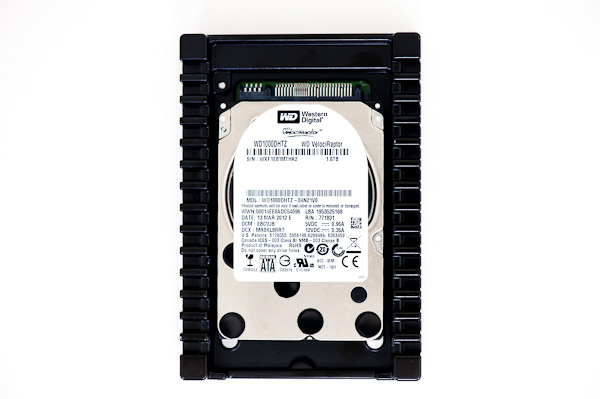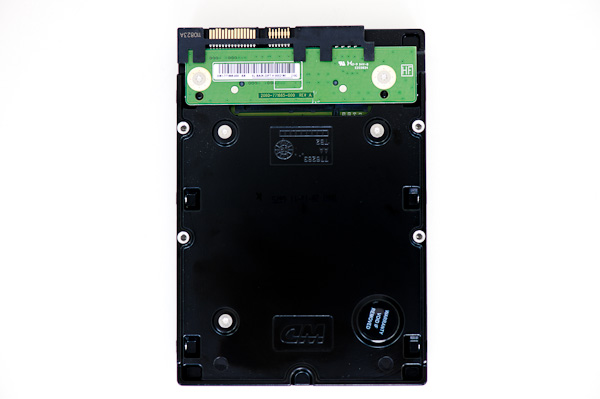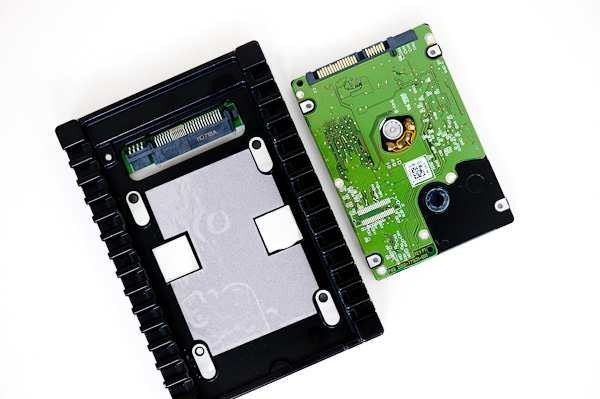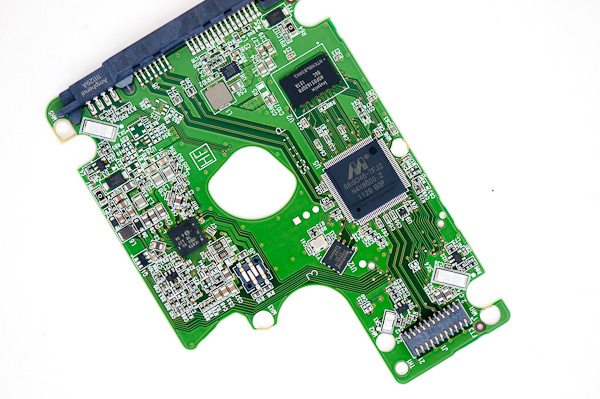Western Digital VelociRaptor 1TB (WD1000DHTZ) Review
by Anand Lal Shimpi on April 16, 2012 8:00 AM EST- Posted in
- Storage
- HDDs
- Western Digital
- VelociRaptor
There was a time when Western Digital's Raptor (and later, the VelociRaptor) was a staple of any high-end desktop build. Rotational media could only deliver better performance by increasing aereal density or spindle speed. In a world dominated by hard drives that focused on the former, WD decided to address both. By shipping the only mainstream (e.g. not SCSI or SAS) 3.5" hard drive with a 10,000 RPM spindle speed, WD guaranteed that if you needed performance, the Raptor line was the way to go.
Two years ago we met the most recent update to the VelociRaptor line: the VR200M. While it raised the bar for the VelociRaptor, WD saw its flagship competing in a new world. SSDs were now more affordable, resulting in even more desktop builds including an SSD. Although the high dollar-per-GB cost associated with SSDs demanded that desktop users adopt a two-drive model (SSD + HDD), for storage of large media files a standard 5400RPM or 7200RPM drive was just fine. After all, moving large files is mostly a sequential operation which plays to the strengths of most consumer drives to begin with.
There are still users who need more storage than an SSD can affordably provide, and who demand speed as well. Although photo and video editing is great on an SSD, a big enough project would have difficulty sharing a 128GB SSD with an OS, applications and other data. For those users who still need high performance storage that's more affordable than an SSD, the VelociRaptor is still worthy of consideration. There's just one problem: Moore's Law is driving the cost of SSDs down, and their capacities up. The shift to solid state storage is inevitable for most, but to remain relevant in the interim the VelociRaptor needed an update.
Today Western Digital is doing just that. This is the new VelociRaptor, available in 250GB, 500GB and 1TB capacities:
| WD VelociRaptor Historical Comparison | |||||
| WD VelociRaptor VR333M | WD VelociRaptor VR200M | WD VelociRaptor VR150M | |||
| Capacity | 1000/500/250GB | 600/450GB | 300/150GB | ||
| Interface | 6Gbps SATA | 6Gbps SATA | 3Gbps SATA | ||
| Advanced Format (4K Sectors) | Y | N | N | ||
| Rotational Speed | 10000 RPM | 10000 RPM | 10000 RPM | ||
| Buffer Size | 64MB | 32MB | 16MB | ||
| Transfer Rate Buffer to Disk | 200 MB/s | 145 MB/s | 128 MB/s | ||
| Platter Density | 333GB | 200GB | 150GB | ||
| Warranty | 5 years | 5 years | 5 years | ||
The basic design remains unchanged. Take a 2.5" drive with platters spinning at 10,000 RPM and pair it with a 3.5" adapter that also acts as a heatsink. Internally the drive gets all of the expected updates. Platter density is now up to 333GB (3 platters for the 1TB drive, 2 for the 500GB drive and 1 for the 250GB). All members of the new VelociRaptor family feature a 64MB DDR3 cache. Combine that with some firmware updates and you've got a recipe for larger capacities and higher performance.
The drive is available today and retails for $319 for the 1TB model, $209 for the 500GB model and $159 for 250GB. These prices are a bit lower than what the VelociRaptor VR200M launched at two years ago (the 500GB is significantly cheaper than the old 450GB launched at).
| WD VelociRaptor Lineup | ||||||
| WD1000DHTZ | WD5000HHTZ | WD2500HHTZ | ||||
| Capacity | 1TB | 500GB | 250GB | |||
| MSRP | $319.99 | $209.99 | $159.99 | |||
| Cost per GB | $0.319 | $0.419 | $0.639 | |||
Compared to standard 3.5" drives, the VelociRaptor is quite expensive. You can buy a 3TB 7200RPM drive at roughly $0.06 per GB, compared to $0.319 per GB for the most cost effective VelociRaptor. Compared to an SSD however, the VRs are still cheaper - although not by a ton if you compare to a low capacity drive. Samsung's SSD 830 (128GB) will cost you $1.36 per GB.














92 Comments
View All Comments
TiGr1982 - Tuesday, April 17, 2012 - link
I've read similar feedback from the person running 6 years old Raptor. He wrote the same - S.M.A.R.T. is fully clean after 6 years of intensive use. If so, Raptor robustness and longevity deserves real respect.Casper42 - Monday, April 16, 2012 - link
I can still see this being used in a decent gaming rig.120 / 160GB SATA 6Gb SSD for OS and Basic Apps
500GB / 1TB VR333M for Games (my Steam folder just keeps growing and growing) and any Video Editing
2 / 3 / 4 TB "Green" drive for Data Files and to backup (offline) the SSD occasionally.
Then a SATA Optical drive as well.
All that fits easily in most mATX Cases and only needs 4 SATA connections.
I am running a 64GB / 600GB VR / 2 x 2TB Green setup in my main machine currently and I can say it works very well. Most FPS style games these days are very sequential Reads because when you load a map its usually a several hundred MB file which Windows will try to keep sequential (defragged)
MichaelD - Monday, April 16, 2012 - link
I finally moved to a SSD for a System drive a few months ago; awesome improvement. However, many gamers (like me) looking for a fast drive to load games from can't afford a large SSD.I have a 150GB Velociraptor from a few years back; it can't hold all my games so I'm not using it. The new 500GB model is exactly what I've been waiting for; and it's at a reasonable pricepoint too. I haven't found any online yet. Any idea where to look and when they'd be available?
patpro - Tuesday, April 17, 2012 - link
Unfortunately, the solution consisting in pairing a SSD with a HDD is mostly "Windows only". I'm using Mac OS X, FreeBSD, and Linux (on different computers), and there is no consumer product for me to create a bundle of SSD/HDD with a software caching solution. Needless to say I'm a big advocate of hardware solutions, anything that would work without installing a dedicated software on the OS.Hard drives with 32 or 34 GB nand flash read/write cache on top of good old platters would be so great...
Traciatim - Tuesday, April 17, 2012 - link
Is there any way you can test drives in real world scenarios? Sure 4K random reads are nice to show the differences between SSD's and Platters, but in the real world how many scenarios are you really going to see that kind of data access?It would be nice if you would run something like Ultimate Defrag and run through some common level load tests games, boot times, Launch three applications sequentially, launch three applications at the same time, a virus scan, and all kinds of other common tasks like these.
MichaelD - Tuesday, April 17, 2012 - link
After reading the comments about the Seagate Momentus XT drives, I did some research and was pretty blown away. The XTs truly seem like the drives to beat. The responsiveness of a SSD with the capacity of a platter-based HD for a very reasonable price. A certain egg-ish etailer even has a sale on them ATM. I bought two of the 500GB drives last night. One for my netbook to replace it's 5400-rpm drive and the other to load my games from on my PC. Thanks for pointing out the XT drives, guys!TiGr1982 - Tuesday, April 17, 2012 - link
Indeed, Seagate Momentus XT IS the way to go for upgrade. Recently I upgraded my laptop (Acer 7552G, Win 7 SP1, AMD Danube platform, SB850 southbridge) with Seagate Momentus XT 750 GB, and now it runs MUCH faster than before, because HDD is no longer the bottleneck. I hope, so will be the case for you :)The only probable caveat is there can be compatibility issues with Momentus XT, but, as far as I know, these problems can happen only on Mac laptops, not PC laptops.
TiGr1982 - Tuesday, April 17, 2012 - link
These are my 2 cents. Everybody, including Anand himself, is complaining about the absence of NAND flash in new Raptors. My personal opinion is as follows: WD ARE HDD guru's, and their overall HDD market record is nice, but, probably, up to now, they didn't make the proper R'n'D effort to integrate the NAND. So now, looking at Seagate, even if they appreciate the advantage of employing internal NAND in HDD for caching, they can't catch up easily.Obviously, looking "under the hood", soldering the NAND flash to the HDD PCB is surely not enough; you need the SSD controller for this NAND and, more important, you need the proper firmware to use this NAND reasonably, together with the main storage, i.e. disk platters. I believe, developing of this firmware itself is not so simple. Recall that Seagate was polishing the firmware for the first gen Momentus XT (500 GB, 4 GB NAND) for around a year AFTER its actual release on the market. Same thing probably will happen with the second gen of Momentus XT (750 GB, 8 GB NAND) . This circumstance clearly points out that even in Seagate case, the whole hybrid tech is in the intermediate, but not final, stage.
Also, recall that Seagate started experimenting with flash in HDD in Windows Vista times, with Momentus PSD, around 2007, which is an "ancient time" on computer hardware timescale.
So, what do you want from WD? :)
TiGr1982 - Tuesday, April 17, 2012 - link
Saying, R'n'D, I actually meant R&D, just the notations, you understand :)JimmiG - Wednesday, April 18, 2012 - link
I went with a standard 7200 RPM, 1TB drive and then added a 64GB OCZ Synapse Cache SSD. The SSD costs $100, so the total is still lower than the Velociraptor. It's the "dream" mentioned in the conclusion and it's already here (as long as you don't mind running Windows 7, and have the space for two drives).